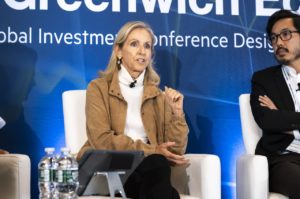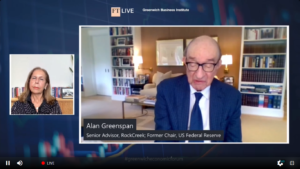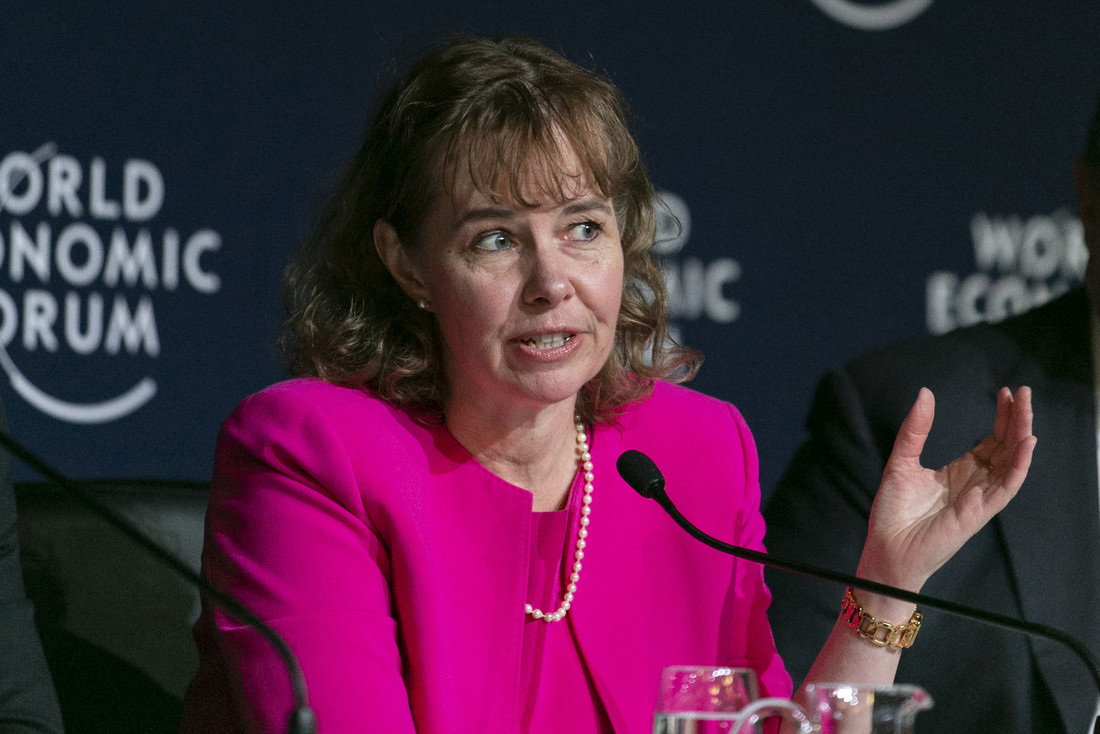Cryptocurrency and blockchain, along with building a greener world and improving health care, were some of the major topics discussed during this year”™s Greenwich Economic Forum.
But the GEF ended with a conversation with former U.S. Federal Reserve Chairman Alan Greenspan, now a senior advisor at RockCreek Global Investment Management, who was interviewed via Zoom by that firm”™s founder and CEO Anshula Kant. She noted that the 95-year-old savant regularly comes into the firm”™s D.C. office and “is not a hybrid worker.”

Greenspan mentioned that the work-from-home model during the height of the pandemic succeeded well beyond many widely held assumptions. He added, however, that another assumption ”” that “we would all get vaccinated, reopen and everyone would be back in the office” ”” has also been disproved.
In many cases, “Workers are in no rush to return to the office,” he said. “Work-from-home will simply be a part of the new normal.” Protracting that trend will continue to benefit the tech sector, he added, while also persist in posing challenges for the commercial real estate sector.
Greenspan expressed concern over the inequality in how Covid vaccines have been distributed, with those in developed countries inarguably receiving more doses than those in underdeveloped nations. While the U.S. and U.K. had fully vaccinated rates of about 54% and 65% respectively on Sept. 23, less than 4% of Africa”™s population had reached the same milestone.
Such a disparity will have “serious economic consequences,” he warned, helping to cost the world economy $2.3 trillion during the 2022 to 2025 period ”” roughly the equivalent of France”™s annual GDP. Asia would be the most affected, losing a total of $1.7 trillion during those years, “but Africa will stomach the highest losses” on a per-capita and health basis.
Greenspan ”” who held the Fed Reserve chair for 19 years under four U.S. presidents (three Republicans and one Democrat) ”” was asked if such longevity was a plus to the overall economic picture, given that President Joe Biden is reportedly considering asking current chairman, Jerome Powell ”” who was appointed by Donald Trump in 2018 ”” to remain.
“The most important attribute of the fed chairman and the federal reserve ”¦ is political independence,” he replied. “Any change should be without political pressure,” Greenspan said, also decrying “continuity for continuity”™s sake.”
Continuity is hardly the byword for the cryptocurrency and blockchain sectors, as opinions continue to differ as to where such markets are heading ”” especially among regulators.
Prior to the GEF, SEC Chairman Gary Gensler told the Senate Banking Committee that the commission is working on stricter regulations on digital assets and coins such as stablecoins, the digital currency whose performance is attached to such underlying assets as a national currency or gold.

Gensler estimated that there are approximately 6,000 such digital assets.
“Currently, we just don”™t have enough investor protection in crypto finance, issuance, trading, or lending,” Gensler said in prepared remarks. “Frankly, at this time, it”™s more like the Wild West or the old world of ”˜buyer beware”™ that existed before the securities laws were enacted.”
During one GEF panel, Michelle Seitz, chairman and CEO, Russell Investments, opined that although it”™s been “easy to dismiss” digital assets, “The real investors are coming.” Fellow panelist Anastasia Amoroso, chief investment strategist at iCapital, went further by predicting this will be “a breakout year for crypto, not just in performance but in adoption.”
Amoroso said both small and large businesses are increasingly adding crypto as a form of payment, and predicted that it ultimately will disrupt the consumer payment market. ResearchAndMarkets.com estimated in June that the transaction value for the global digital payments market was $5.4 trillion last year, and predicted it will grow to nearly $11.3 trillion by 2026.
During a separate session, Grayscale Investments CEO Michael Sonnenshein said that, despite there being insufficient regulatory clarity around digital investments, the market “has really arrived and it is really here to stay.”
Sonnenshein said that ultimately an act of Congress will be necessary to codify digital asset regulations, “and that”™s not an overnight development.”
Meanwhile, environmental, social, and corporate governance (ESG) investing has quickly grown from the “nice thing to do” to “must-do” for an increasing number of companies. With climate change becoming more evident to more people, companies can no longer afford to ignore such concerns, said Hunter Point Capital Executive Chairman Bennett Goodman.
He noted, however, that while public companies have already been making progress on green efforts, “private markets have been slower to adopt various ESG initiatives.”
Add national governments to the list of those getting greener. John Glen, economic secretary to the treasury in the U.K., was on hand to tout the out-of-the-box success of that government”™s first round of green bonds: £10 billion ($13.7 billion) was raised during its first morning of sales on Sept. 21, with orders placed for another £90 billion ($123 billion) ”” a record for a U.K. government bond sale. “We are significantly oversubscribed,” Glen said.
“We”™re sending a signal to the market that we think will stimulate” further interest in green bonds, he added. “The appetite is out there to find these kinds of instruments.”
The bonds are set to mature in June 2032 and July 2033. Another round of £5 billion ($6.8 billion) is expected later this year.
In addition, Annie Lamont ”” the governor”™s wife, and co-founder and managing Partner at Oak HC/FT Partners in Greenwich ”” was on hand for a panel discussion on the evolution of health care systems.
“Technology is not the issue,” she said. “It”™s about interchange and payment reform.”
Covid-19 has been “an accelerant in terms of collaboration and innovation,” Lamont said, with the move toward home care and telehealth continuing to gain momentum. “80% of health care can actually be delivered at the home,” she said.
Giving personal care physicians more control over, and thus engagement in, an individual”™s health regime will result in a move from the current “hospital-centric to a more care-centric system,” she added.


















